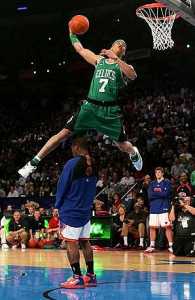First, I want to discuss the biggest misconception, WHAT EXACTLY IS A VERTICAL JUMP? We hear people’s opinions about what a vertical is…we’ve seen the NFL combine on ESPN and we know how the NFL tests it (1-step vertical). But when it comes to basketball, what is a real vertical? We all know building jumping ability and vertical leap is an important part of basketball training, so let’s take a minute to clear up some misconceptions.
The first step to finding a vertical is to find a player’s max standing reach. A player stands against a wall or under a vertical jump testing machine and extends their arm reaching up as far as possible with one arm (with feet flat); this is the player’s standing reach. Next, you measure the jump…
The 2 types of vertical jumps
1. No Step Vert – The No Step Vert is exactly what it sounds like. The player stands with their feet planted, they then jump straight up and reach up as high as possible touching a wall, target, or the spinning tabs of a vertical jump testing machine. The highest point touched is measured. To get the vertical jump height, simply subtract the max standing reach from the highest point touched.
2. Max Vert – This is basically the same, except in this test, the player gets to take a short run-up before jumping. Again, the highest point touched is measured. To get the vertical jump height, simply subtract the max standing reach from the highest point touched.
We have all heard the claims of 58” verticals, 52” verticals, and programs that give you an extra 12” of vertical in a month. Let’s look at a few facts from the pre-draft NBA combine that takes place each year.
- The highest “no-step” vertical measured since 1998 was completed by Nick Young in 2007, his jump was 39.5”
- The highest “max vert” jump since ’98 was Kenny Gregory’s 45.5” jump in 2001, 2nd best belongs to Nate Robinson at 43.5
Here is how a few of the current big leapers tested:
- Dwayne Wade comes in at 31.5” & 35” in the no step & max
- Blake Griffin measured at 32” & 35.5” (no step & max)
- Carmello Anthony jumped 30.5” & 33.5” (no step & max)
- Derrick Rose = 34.5” & 40” (no step & max)
- Russell Westbrook = 30” & 36.5” (no step & max)
Seeing these actual results of some REAL NBA high-flyers clearly shows that all those vertical jump guides are a little bit bogus. The problem is, at some point, people decided that selling vertical jump tools and programs was a great way to make money. There were special shoes, shoe attachments, and programs that flooded the internet…all promising HUGE gains and showing phony testimonials of clients with 48” or 52” verticals. Everyone bought them in bunches! But what were the results? They weren’t very good. Some athletes ended up with repetitive stress injuries from endless repetitive high impact exercises at extremely high volume. Some had temporary gains that disappeared. Some got bored with the repetitive day-in day-out grind and quit the programs. Some saw no gains.
The truth is, just like everything else worth doing or having, there is no magic trick. Building explosiveness and jumping ability takes a mix of: poweful and explosive lifts, flexibility & mobility work, plyometrics, and jumping form/technique work. In one study of Olympic athletes, the weightlifters actually had the highest vertical jump of any athletes in the Games. If you are looking to be a great basketball player, what you really need is a well-balanced strength and conditioning program. If you want to put a little emphasis on jumping, you can work with your trainer to build your program with a focus on explosiveness.
Our top 5 exercises for vertical jump improvement:
- Dumbbell Split squats
- Max-Effort box jumps
- Deadlifts
- Weighted lunge switch steps
- No momentum max jumps
What is your vertical? What do you hope to get your vertical up to? Leave your answers in the comments!

 He has 25 years of experience playing basketball, training basketball players, and coaching basketball. The World of Hoops provides intelligent and intense basketball training to take basketball players to the next level.
He has 25 years of experience playing basketball, training basketball players, and coaching basketball. The World of Hoops provides intelligent and intense basketball training to take basketball players to the next level. On Court Behavior
On Court Behavior Chris Paul’s “Grandfather Game”
Chris Paul’s “Grandfather Game” Ball Handling – Eliminate Waste in Your Game
Ball Handling – Eliminate Waste in Your Game Advanced Statistics – What They Mean and How to Use Them
Advanced Statistics – What They Mean and How to Use Them




I’m really enjoying the design and layout of your blog. It’s a
very easy on the eyes which makes it much more pleasant for me to come
here and visit more often. Did you hire out a developer
to create your theme? Fantastic work!
I was glad to find this website, that really puts it all into perspective. That makes me feel pretty good about my vertical. I am 58 years old, and just did a legit 23 inches, which is the best documented record to date. I will be in Dale Harder’s Strength & Speed newsletters upcoming Feb edition. Here is the link to my jump. Thanks
If you do not have a high vertical jump, blame your parents.
The mechanics of your body determines what you can do.
If your dad was Kareem, or Bird, or McHale, you would have a B-Ball body.
If your mom and dad were horse jockeys, don’t expect it.
Had to speak my mind in reference to who wrote this article. Little about me I’m a German American male 36 years old 6’1 without shoes. I have great hand and eye coordination so needless to say I played sports and did well. But never training very hard could dunk when I was in college, but weakly. So this past summer I picked up beach volleyball again and my no step was 28″ . Started researching reading educating myself on the subject of increasing my leap.
Started with plyometrics including explosive squats, got up to 32″ no step vertical in just 7 training sessions. I don’t calculate in weeks cause you need to consider rest time. So after 3 more sessions I felt I was quickly meeting my max, but it wasn’t true. I did more research found a program I won’t mention here cause my point is to prove your believes are wrong. After applying that program for the rest of this summer and including one more tool that adds resistance to your plyometric workouts, I now no step vertical 35″ and max vertical leap 38″
That’s a total of 10″ tho I didn’t measure my max vertical only no step before starting. Pointis working hard and pushing to the limits will always produce gains. I’m proof your articles claims are wrong, plus those athletes you used to try and prove a point aren’t some of the great leapers, they’re just tall with decent hops. With standing reaches well over 9 foot. Dwayne Wade even has 8’6 reach. Don’t really need to train very hard to dunk on a rim when it’s 10 foot high, I mean why would he spend time on vertical leap if one he can dunk already two has a decent 30 plus no step vert. Think he’d spend time on skills training.
Bottom line what’s out there works if you apply it , work hard, rest, eat well, and stretching just as hard as the workout.
See you at 40″ that’s my goal and, little fact by the way look at the vertical jump world record if you think 50″ plus can’t be achieved. Then go ask that person if he just woke up and could jump 50″ with just box’s jumps and squats. Save your time answers going to be NO.
You can achieve 7 inches like you did, if your starting point is as low as 28”. I started off with 29.5” and ended up with 34 max. Now Im back to 32 because I put on 22 lb of muscle this year. But every inch was harder to gain than the one before. Bottom line is, the higher the vert, the harder it is to add inches.
Hi Joe
Currently in NBA draft measurements. Do they use no step vert or one step vert ?
They actually use both!